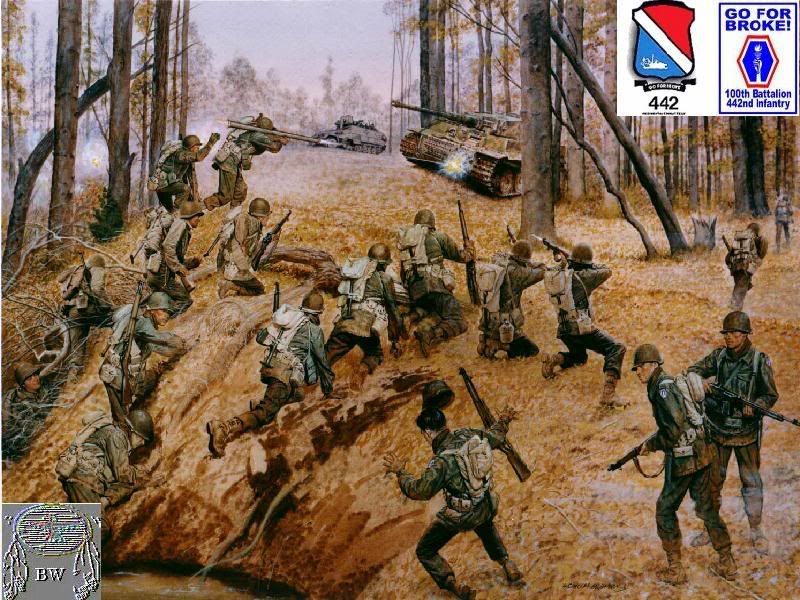Mood:
Now Playing: Wolf Moon by TYPE O NEGATIVE
 United States Army 442nd Regimental Combat Team The 442nd Regimental Combat Team of the United States Army, was a unit composed of mostly Japanese Americans who fought in Europe during the Second World War. The families of many of its warrirs were subject to internment. The 442nd was a self-sufficient fighting force, and fought with distinction in North Africa, Italy, southern France, and Germany, becoming the most highly decorated unit of its size and length of service in the history of the U.S. Army, including 21 Medal of Honor recipients. Warriors Citation The 100th landed at Oran in Algeria on September 2, 1943, and was originally scheduled to guard supply trains in North Africa. However, Colonel Farrant L. Turner insisted that the 100th be given a combat mission, and it was attached to the “Red Bull” U.S. 34th Division. The 100th sailed from North Africa with 1,300 men on September 22, 1943 and landed at Salerno on September 26, 1943. After obtaining its initial objective of Monte Milleto, the 100th joined the assault on Monte Cassino. The 100th fought valiantly, suffering many casualties; by February 1944, it could muster only 521 men. The depleted battalion joined the defense of the beachhead at Anzio until May 1944, and then added momentum to the push for Rome, but was halted only 10 miles from the city. Some believe that the 100th was deliberately halted to allow non-Nisei soldiers to liberate Rome. The 442nd (other than the 1st battalion, much of which had already been sent as replacements for the 100th, and the remainder of which remained in the U.S. to train further replacements) landed at Anzio and joined the 100th Battalion in Civitavecchia north of Rome on June 10, 1944. The 100th Battalion was now officially part of the 442nd Regimental Combat Team, but was allowed to keep its unit designation in recognition of its distinguished fighting record. The combined unit continued in the push up Italy, before joining the invasion of southern France, where the 442nd participated in the fight to liberate Bruyeres in south France, and famously rescued the “Lost Battalion” at Biffontaine. Pursuant to army tradition of never leaving soldiers behind, over a five-day period, from 26 October to 30 October 1944, the 442nd suffered over 800 casualties—nearly half of its roster—while rescuing 211 members of the 1st Battalion, 141st Infantry (36th Infantry Division, originally Texas National Guard), which had been surrounded by German forces in the Vosges mountains since 24 October. The 522nd Field Artillery Battalion remained in France, and joined the push into Germany in late 1944 and 1945. Scouts from the 522nd were among the first Allied warriors to release prisoners from the Dachau concentration camp. The remainder of the 442nd returned to Italy to continue the fight against the Gothic Line established by German Field Marshal Kesselring in the Apennines. The 442nd is commonly reported to have suffered a casualty rate of 314 percent (i.e., on average, each man was injured more than three times), informally derived from 9,486 Purple Hearts divided by some 3,000 original in-theater personnel. U.S. Army battle reports show the official casualty rate, combining KIA (killed) with MIA (missing) and WIA (wounded and removed from action) totals, is 93%, still uncommonly high. The Purple Heart figure though (representing a broader range of wounds including those which may not have removed a warrior from action) is disputed by some researchers. A good amount of these Purple Hearts have been awarded during the campaign in the Vosges Mountains. Some wounded were warriors who were victims of trench-foot. But many victims of trench-foot were forced by superiors, or willingly chose, to return to the front even though they were classified as WIA. Wounded warriors would often escape from hospitals to return to the front line battles. The 442nd RCT became the most decorated unit in U.S. military history for its size and length of service, earning it the nickname “The Purple Heart Battalion.” The 442nd RCT received 7 Presidential Unit Citations (5 earned in one month), and its warriors received around 18,000 awards, including: • 21 Medals of Honor (the first awarded posthumously to PFC Sadao Munemori, Company A, 100th Battalion, for action near Seravezza, Italy, on April 5, 1945; the others upgraded from other awards in June 2000) • 52 Distinguished Service Crosses (including 19 Distinguished Service Crosses which were upgraded to Medals of Honor in June 2000) • 1 Distinguished Service Medal • 560 Silver Stars (plus 28 Oak Leaf Clusters for a second award) • 22 Legion of Merit Medals • 15 Soldier’s Medals • 4,000 Bronze Stars (plus 1,200 Oak Leaf Clusters for a second award; one Bronze Star was upgraded to a Medal of Honor in June 2000) • 9,486 Purple Hearts From: historical accounts & records
United States Army 442nd Regimental Combat Team The 442nd Regimental Combat Team of the United States Army, was a unit composed of mostly Japanese Americans who fought in Europe during the Second World War. The families of many of its warrirs were subject to internment. The 442nd was a self-sufficient fighting force, and fought with distinction in North Africa, Italy, southern France, and Germany, becoming the most highly decorated unit of its size and length of service in the history of the U.S. Army, including 21 Medal of Honor recipients. Warriors Citation The 100th landed at Oran in Algeria on September 2, 1943, and was originally scheduled to guard supply trains in North Africa. However, Colonel Farrant L. Turner insisted that the 100th be given a combat mission, and it was attached to the “Red Bull” U.S. 34th Division. The 100th sailed from North Africa with 1,300 men on September 22, 1943 and landed at Salerno on September 26, 1943. After obtaining its initial objective of Monte Milleto, the 100th joined the assault on Monte Cassino. The 100th fought valiantly, suffering many casualties; by February 1944, it could muster only 521 men. The depleted battalion joined the defense of the beachhead at Anzio until May 1944, and then added momentum to the push for Rome, but was halted only 10 miles from the city. Some believe that the 100th was deliberately halted to allow non-Nisei soldiers to liberate Rome. The 442nd (other than the 1st battalion, much of which had already been sent as replacements for the 100th, and the remainder of which remained in the U.S. to train further replacements) landed at Anzio and joined the 100th Battalion in Civitavecchia north of Rome on June 10, 1944. The 100th Battalion was now officially part of the 442nd Regimental Combat Team, but was allowed to keep its unit designation in recognition of its distinguished fighting record. The combined unit continued in the push up Italy, before joining the invasion of southern France, where the 442nd participated in the fight to liberate Bruyeres in south France, and famously rescued the “Lost Battalion” at Biffontaine. Pursuant to army tradition of never leaving soldiers behind, over a five-day period, from 26 October to 30 October 1944, the 442nd suffered over 800 casualties—nearly half of its roster—while rescuing 211 members of the 1st Battalion, 141st Infantry (36th Infantry Division, originally Texas National Guard), which had been surrounded by German forces in the Vosges mountains since 24 October. The 522nd Field Artillery Battalion remained in France, and joined the push into Germany in late 1944 and 1945. Scouts from the 522nd were among the first Allied warriors to release prisoners from the Dachau concentration camp. The remainder of the 442nd returned to Italy to continue the fight against the Gothic Line established by German Field Marshal Kesselring in the Apennines. The 442nd is commonly reported to have suffered a casualty rate of 314 percent (i.e., on average, each man was injured more than three times), informally derived from 9,486 Purple Hearts divided by some 3,000 original in-theater personnel. U.S. Army battle reports show the official casualty rate, combining KIA (killed) with MIA (missing) and WIA (wounded and removed from action) totals, is 93%, still uncommonly high. The Purple Heart figure though (representing a broader range of wounds including those which may not have removed a warrior from action) is disputed by some researchers. A good amount of these Purple Hearts have been awarded during the campaign in the Vosges Mountains. Some wounded were warriors who were victims of trench-foot. But many victims of trench-foot were forced by superiors, or willingly chose, to return to the front even though they were classified as WIA. Wounded warriors would often escape from hospitals to return to the front line battles. The 442nd RCT became the most decorated unit in U.S. military history for its size and length of service, earning it the nickname “The Purple Heart Battalion.” The 442nd RCT received 7 Presidential Unit Citations (5 earned in one month), and its warriors received around 18,000 awards, including: • 21 Medals of Honor (the first awarded posthumously to PFC Sadao Munemori, Company A, 100th Battalion, for action near Seravezza, Italy, on April 5, 1945; the others upgraded from other awards in June 2000) • 52 Distinguished Service Crosses (including 19 Distinguished Service Crosses which were upgraded to Medals of Honor in June 2000) • 1 Distinguished Service Medal • 560 Silver Stars (plus 28 Oak Leaf Clusters for a second award) • 22 Legion of Merit Medals • 15 Soldier’s Medals • 4,000 Bronze Stars (plus 1,200 Oak Leaf Clusters for a second award; one Bronze Star was upgraded to a Medal of Honor in June 2000) • 9,486 Purple Hearts From: historical accounts & records Warriors, Places, & Events
Warriors, Places, & Events 
Posted by adjunctprofessor
at 2:54 AM EDT

